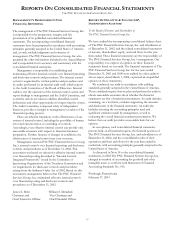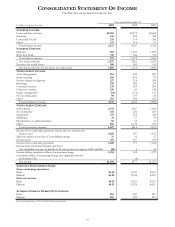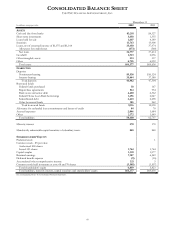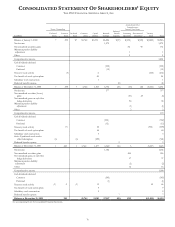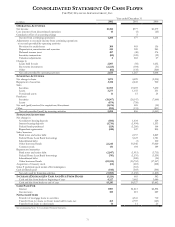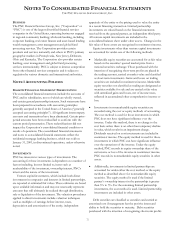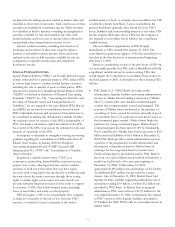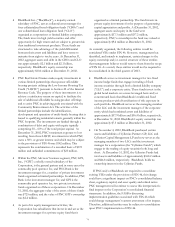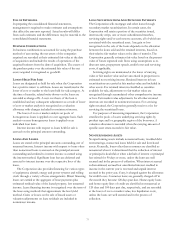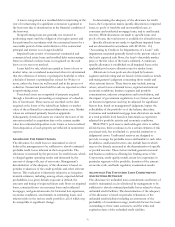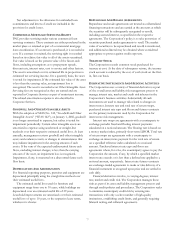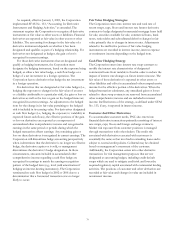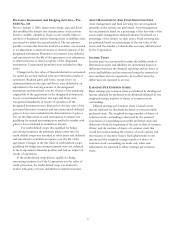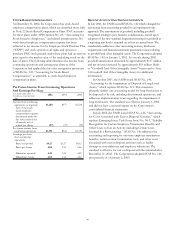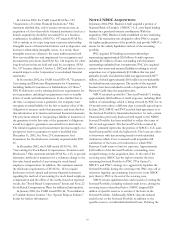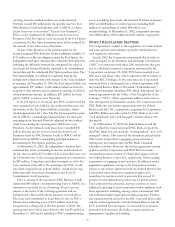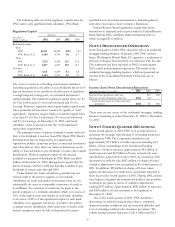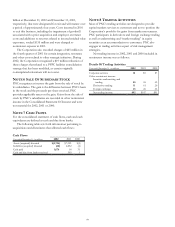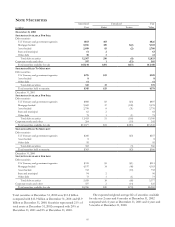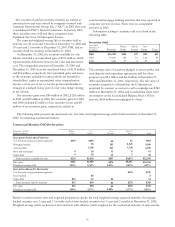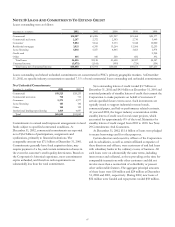PNC Bank 2002 Annual Report Download - page 79
Download and view the complete annual report
Please find page 79 of the 2002 PNC Bank annual report below. You can navigate through the pages in the report by either clicking on the pages listed below, or by using the keyword search tool below to find specific information within the annual report.77
Net adjustments to the allowance for unfunded loan
commitments and letters of credit are included in the
provision for credit losses.
COMMERCIAL MORTGAGE SERVICING RIGHTS
PNC provides servicing under various commercial loan
servicing contracts. These contracts are either purchased in the
market place or retained as part of a commercial mortgage
loan securitization. If a contract is purchased, it is recorded at
cost. If a contract is retained, the servicing right is recorded
based on its relative fair value to all of the assets securitized.
Fair value is based on the present value of the future cash
flows, including assumptions as to prepayment speeds,
discount rate, interest rates, cost to service and other factors.
The asset is amortized over its estimated life in proportion to
estimated net servicing income. On a quarterly basis, the asset
is tested for impairment. If the estimated fair value of the asset
is less than the carrying value, an impairment loss is
recognized. The asset is recorded as an Other Intangible Asset.
Servicing fees are recognized as they are earned and are
reported in Corporate Services as part of noninterest income.
The related amortization expense is also classified in
Corporate Services.
GOODWILL AND OTHER INTANGIBLE ASSETS
With the adoption of SFAS No. 142, “Goodwill and Other
Intangible Assets” (“SFAS 142”), on January 1, 2002, goodwill
is no longer amortized to expense, but rather is tested for
impairment periodically. Certain other intangible assets are
amortized to expense using accelerated or straight-line
methods over their respective estimated useful lives. At least
annually, management reviews goodwill and other intangible
assets and evaluates events or changes in circumstances that
may indicate impairment in the carrying amount of such
assets. If the sum of the expected undiscounted future cash
flows, excluding interest charges, is less than the carrying
amount of the asset, an impairment loss is recognized.
Impairment, if any, is measured on a discounted future cash
flow basis.
DEPRECIATION AND AMORTIZATION
For financial reporting purposes, premises and equipment are
depreciated principally using the straight-line method over
their estimated useful lives.
The estimated useful lives used for furniture and
equipment range from one to 10 years, while buildings are
depreciated over an estimated useful life of 39 years.
Leasehold improvements are amortized over their estimated
useful lives of up to 10 years, or the respective lease terms,
whichever is shorter.
REPURCHASE AND RESALE AGREEMENTS
Repurchase and resale agreements are treated as collateralized
financing transactions and are carried at the amounts at which
the securities will be subsequently reacquired or resold,
including accrued interest, as specified in the respective
agreements. The Corporation’s policy is to take possession of
securities purchased under agreements to resell. The market
value of securities to be repurchased and resold is monitored,
and additional collateral may be obtained where considered
appropriate to protect against credit exposure.
TREASURY STOCK
The Corporation records common stock purchased for
treasury at cost. At the date of subsequent reissue, the treasury
stock account is reduced by the cost of such stock on the first-
in, first-out basis.
DERIVATIVE INSTRUMENTS AND HEDGING ACTIVITIES
The Corporation uses a variety of financial derivatives as part
of the overall asset and liability risk management process to
manage interest rate, market and credit risk inherent in the
Corporation’s business activities. Substantially all such
instruments are used to manage risk related to changes in
interest rates. Interest rate and total rate of return swaps,
purchased interest rate caps and floors and futures contracts
are the primary instruments used by the Corporation for
interest rate risk management.
Interest rate swaps are agreements with a counterparty to
exchange periodic fixed and floating interest payments
calculated on a notional amount. The floating rate is based on
a money market index, primarily short-term LIBOR. Total rate
of return swaps are agreements with a counterparty to
exchange an interest rate payment for the total rate of return
on a specified reference index calculated on a notional
amount. Purchased interest rate caps and floors are
agreements where, for a fee, the counterparty agrees to pay the
Corporation the amount, if any, by which a specified market
interest rate exceeds or is less than a defined rate applied to a
notional amount, respectively. Interest rate futures contracts
are exchange-traded agreements to make or take delivery of a
financial instrument at an agreed upon price and are settled in
cash daily.
Financial derivatives involve, to varying degrees, interest
rate, market and credit risk. The Corporation manages these
risks as part of its asset and liability management process and
through credit policies and procedures. The Corporation seeks
to minimize counterparty credit risk by entering into
transactions with only a select number of high-quality
institutions, establishing credit limits, and generally requiring
bilateral netting and collateral agreements.


